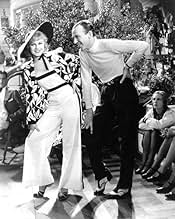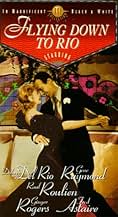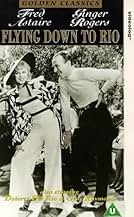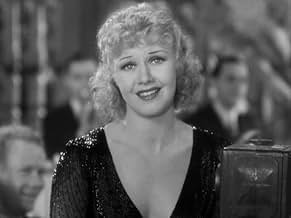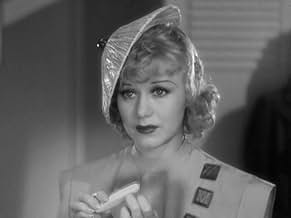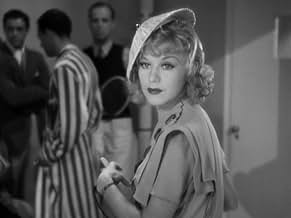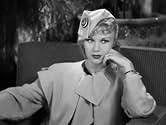ÉVALUATION IMDb
6,6/10
4,2 k
MA NOTE
Ajouter une intrigue dans votre langueA bandleader woos a Latin flame who is already engaged to his employer.A bandleader woos a Latin flame who is already engaged to his employer.A bandleader woos a Latin flame who is already engaged to his employer.
- Nommé pour 1 oscar
- 1 victoire et 2 nominations au total
Dolores Del Río
- Belinha De Rezende
- (as Dolores Del Rio)
Luis Alberni
- Rio Casino Manager
- (uncredited)
Bernice Alstock
- Singer
- (uncredited)
Chita Andrews
- Check Girl
- (uncredited)
Avis en vedette
By the time Flying Down to Rio was released in 1933, It was Warner Brothers who had been having the success as far as musicals were concerned.
Ruby Keeler and Dick Powell were the uncrowned King and Queen of song and dance land and in films like 42nd Street, Footlight Parade and Gold Diggers and the later movies Dames and Flirtation Walk they were paving the way for a motion picture genre that would continue in much the same vein for the next twenty years.
With kaleidescope routines expertly directed by Busby Berkeley via overhead cameras, the movie musical was finally taking shape bearing little or no resemblance to earlier dismal efforts like MGM'S Broadway Melody of 1929 or their equally unimpressive Hollywood Review from the same year.
RKO was at the time a struggling studio with huge debts and was on the verge of going bankrupt. However they decided to capitalize on this medium in an effort to pull themselves back into the black.
Flying Down to Rio was in all respects no different to any other of the films they produced at the time and I'm sure this film would have sank into obscurity and be long forgotten had it not been for the movie milestone it boasts.
Fred Astaire and Ginger Rogers were cast as only 3rd and 4th billed performers, to all intents and purposes, the token dance act, a novelty. Neither of them had done much before. Ginger of course was beginning to make a name for herself. She had featured in both the fore-mentioned 42nd Street and Gold Diggers and was slowly working her way out of chorus lines into bit parts and the occasional solo number.
Fred had done less still. Already a well known stage star in America and Britain, he had just one previous film under his belt. A natural dancer of extraordinary talent, Fred was signed on as RKO's secret weapon in their efforts to make the best musicals.
However, no matter how dull the storyline to "Rio" is (and it is believe me) it is soon forgotten when Fred and Ginger perform their first ever screen dance, The Carioca, a musical number with Latin- American tempo complete with stunning costumes, guest singers and the very kaleidoscopic shots of which Busby Berkeley himself would have been proud. It is their only dance together in the film and their actual dancing is given very limited screen-time, but it was enough to cause Astaire/Rogers mania.
Forgive the cliche but the rest is history as they say.
So successful were they that they went on to appear in a further nine films together making them one of the most beloved and cherished screen partnerships ever.
Alone the Astaire/Rogers musicals of the thirties saved the studio from closure and they helped push Warner's, Keeler and Powell into second place, at least as far as musicals were concerned.
Astaire is given further opportunity to shine in two stunning solos which will leave the viewer in no doubt whatsoever why he was the very best at his chosen craft.
Complete with the now famous 'girls-strapped-onto-aeroplane-wings' scene and with the added talents of Delores Del Rio and Gene Raymond adding the romance, It all helps to make an otherwise dull film into a legendary silver screen gem.
Ruby Keeler and Dick Powell were the uncrowned King and Queen of song and dance land and in films like 42nd Street, Footlight Parade and Gold Diggers and the later movies Dames and Flirtation Walk they were paving the way for a motion picture genre that would continue in much the same vein for the next twenty years.
With kaleidescope routines expertly directed by Busby Berkeley via overhead cameras, the movie musical was finally taking shape bearing little or no resemblance to earlier dismal efforts like MGM'S Broadway Melody of 1929 or their equally unimpressive Hollywood Review from the same year.
RKO was at the time a struggling studio with huge debts and was on the verge of going bankrupt. However they decided to capitalize on this medium in an effort to pull themselves back into the black.
Flying Down to Rio was in all respects no different to any other of the films they produced at the time and I'm sure this film would have sank into obscurity and be long forgotten had it not been for the movie milestone it boasts.
Fred Astaire and Ginger Rogers were cast as only 3rd and 4th billed performers, to all intents and purposes, the token dance act, a novelty. Neither of them had done much before. Ginger of course was beginning to make a name for herself. She had featured in both the fore-mentioned 42nd Street and Gold Diggers and was slowly working her way out of chorus lines into bit parts and the occasional solo number.
Fred had done less still. Already a well known stage star in America and Britain, he had just one previous film under his belt. A natural dancer of extraordinary talent, Fred was signed on as RKO's secret weapon in their efforts to make the best musicals.
However, no matter how dull the storyline to "Rio" is (and it is believe me) it is soon forgotten when Fred and Ginger perform their first ever screen dance, The Carioca, a musical number with Latin- American tempo complete with stunning costumes, guest singers and the very kaleidoscopic shots of which Busby Berkeley himself would have been proud. It is their only dance together in the film and their actual dancing is given very limited screen-time, but it was enough to cause Astaire/Rogers mania.
Forgive the cliche but the rest is history as they say.
So successful were they that they went on to appear in a further nine films together making them one of the most beloved and cherished screen partnerships ever.
Alone the Astaire/Rogers musicals of the thirties saved the studio from closure and they helped push Warner's, Keeler and Powell into second place, at least as far as musicals were concerned.
Astaire is given further opportunity to shine in two stunning solos which will leave the viewer in no doubt whatsoever why he was the very best at his chosen craft.
Complete with the now famous 'girls-strapped-onto-aeroplane-wings' scene and with the added talents of Delores Del Rio and Gene Raymond adding the romance, It all helps to make an otherwise dull film into a legendary silver screen gem.
Howard Hughes, oh how we needed you.
From other sources you will have learned that this is pretty sexy stuff in terms of transparent clothes; not a bra on the hundreds of candidates. And the original dirty dancing before it was outlawed, and that crack about what Brazilian women have "below the equator." Also, you will have heard about this being the first Astaire-Rogers pairing.
You may not have heard of one of the most racially respectful scenes I know from the era: a couple land on a supposedly deserted island and the woman is frightened by what she thinks are natives. Turns out one comes out of the woods. He's playing golf and while shirtless (in order to make the joke work) speaks English normally and carries himself like a regular man. Its the reverse joke of what you'd usually see in bugeyed stepinfetchits.
But what I find fascinating is the way sex, romance, money and music are all somehow related to aviation. Our hero, we are told is heir to a fortune if only he would give up his music and planes. But it is plain that he does it because of the women. And by that we know he means sex, only sex. We first see him as he climbs out of his plane, which has a piano stuffed in it. Now think about that a minute.
This is what technology meant in those days: adventure, charm, bodily pleasure. And its what the sort of music we see in films was supposed to imply as well. If you do not see this, let me describe the climax. Scores of scantily clad women are strapped to what looks like a dozen small planes to perform choreographically as best you can when bolted down. Every shot you can take of a woman's body is presented, along with a wingload of errant nipples. I can just imagine the smiles when they thought it up.
There's something else to watch for. This has the most elaborate transitions I believe I have seen for any film. They really are amazingly varied and so copious they are as much a feature as Fred's dancing.
Ted's Evaluation -- 2 of 3: Has some interesting elements.
From other sources you will have learned that this is pretty sexy stuff in terms of transparent clothes; not a bra on the hundreds of candidates. And the original dirty dancing before it was outlawed, and that crack about what Brazilian women have "below the equator." Also, you will have heard about this being the first Astaire-Rogers pairing.
You may not have heard of one of the most racially respectful scenes I know from the era: a couple land on a supposedly deserted island and the woman is frightened by what she thinks are natives. Turns out one comes out of the woods. He's playing golf and while shirtless (in order to make the joke work) speaks English normally and carries himself like a regular man. Its the reverse joke of what you'd usually see in bugeyed stepinfetchits.
But what I find fascinating is the way sex, romance, money and music are all somehow related to aviation. Our hero, we are told is heir to a fortune if only he would give up his music and planes. But it is plain that he does it because of the women. And by that we know he means sex, only sex. We first see him as he climbs out of his plane, which has a piano stuffed in it. Now think about that a minute.
This is what technology meant in those days: adventure, charm, bodily pleasure. And its what the sort of music we see in films was supposed to imply as well. If you do not see this, let me describe the climax. Scores of scantily clad women are strapped to what looks like a dozen small planes to perform choreographically as best you can when bolted down. Every shot you can take of a woman's body is presented, along with a wingload of errant nipples. I can just imagine the smiles when they thought it up.
There's something else to watch for. This has the most elaborate transitions I believe I have seen for any film. They really are amazingly varied and so copious they are as much a feature as Fred's dancing.
Ted's Evaluation -- 2 of 3: Has some interesting elements.
In Miami, during the presentation of the Yankee Clippers, the wolf band leader and pilot Roger Bond (Gene Raymond) flirts with the guest Belinha de Resende (Dolores Del Rio) and the stringent hotel manager fires them. However, the band is hired for the opening night of the Atlântico Hotel in Rio de Janeiro, and they need to fly to Brazil.
When Roger meets Belinha in the hall of the hotel, he learns that she lost her flight to Rio and he offers a ride for her in his plane. Roger is forced to land in an island and he immediately fixes the mechanical problem in the plane; however, he lies to Belinha and tells that he can not fix the problem just to spend the night alone with her. But Belinha, who is the fiancée of the Brazilian Júlio, resists to his harassment and later she finds another plane to fly to Rio.
Once in Rio, the infatuated Roger meets his friend Júlio without knowing that he is the fiancé of Belinha, and he tells about his love for the woman. When the Yankee Clippers are ready to open the hotel, powerful bankers that are interested to force the bankruptcy of the Atlântico's owner to take the hotel, send the police since he does not have the permit to anticipate the opening day. However, Roger's friend and musician Fred Ayres (Fred Astaire) proposes an airborne show to the guests. Meanwhile, the brokenhearted Roger decides to return to his country and leave Belinha with Júlio.
"Flying Down to Rio" is the debut of the pair Fred and Ginger in minor support roles. The sappy and naive romance has the Mexican Dolores Del Rio performing a Brazilian sassy woman and Gene Raymond in the lead roles. The footages from Rio de Janeiro in the 30's and the airborne show are the best moments of this film. The funniest thing in "Flying Down to Rio" is that there is no Brazilian actor or actress in the cast. My vote is six.
Title (Brazil): "Voando para o Rio" ("Flying to Rio")
When Roger meets Belinha in the hall of the hotel, he learns that she lost her flight to Rio and he offers a ride for her in his plane. Roger is forced to land in an island and he immediately fixes the mechanical problem in the plane; however, he lies to Belinha and tells that he can not fix the problem just to spend the night alone with her. But Belinha, who is the fiancée of the Brazilian Júlio, resists to his harassment and later she finds another plane to fly to Rio.
Once in Rio, the infatuated Roger meets his friend Júlio without knowing that he is the fiancé of Belinha, and he tells about his love for the woman. When the Yankee Clippers are ready to open the hotel, powerful bankers that are interested to force the bankruptcy of the Atlântico's owner to take the hotel, send the police since he does not have the permit to anticipate the opening day. However, Roger's friend and musician Fred Ayres (Fred Astaire) proposes an airborne show to the guests. Meanwhile, the brokenhearted Roger decides to return to his country and leave Belinha with Júlio.
"Flying Down to Rio" is the debut of the pair Fred and Ginger in minor support roles. The sappy and naive romance has the Mexican Dolores Del Rio performing a Brazilian sassy woman and Gene Raymond in the lead roles. The footages from Rio de Janeiro in the 30's and the airborne show are the best moments of this film. The funniest thing in "Flying Down to Rio" is that there is no Brazilian actor or actress in the cast. My vote is six.
Title (Brazil): "Voando para o Rio" ("Flying to Rio")
There was a golden age of cinema lasting only four or five years - from the end of the silent era to the beginning of the Hays Code, the severe censorship rules which sought to turn cinema from naughty to nice, but in actuality sapped them of their truth and energy.
`Flying Down to Rio' is a classic pre-Hayes code talkie, and its characters have a quality of frankness which endears them to modern audience far more than many later films, whose stilted, conservative quality is somewhat alienating. You'd be surprised at what they could get away with in those days - it would be forty years before a film could get away with a line like that spoken by a starlet of her South American rivals - `What have those girls got below the equator that we haven't got?'
The film, about a love triangle between a Brazilian woman and two members of a swing band, is of course famous for two things - the slightly surreal sequence in which showgirls ride a biplane down to Rio in Busby Berkley-esque formation, and the debut of Fred Astaire and Ginger Rogers as a screen team. It's no wonder that audiences fell in love with the duo, whose `Carioca' is the highlight of the film.
They only made them like this for a little while - more's the shame!
`Flying Down to Rio' is a classic pre-Hayes code talkie, and its characters have a quality of frankness which endears them to modern audience far more than many later films, whose stilted, conservative quality is somewhat alienating. You'd be surprised at what they could get away with in those days - it would be forty years before a film could get away with a line like that spoken by a starlet of her South American rivals - `What have those girls got below the equator that we haven't got?'
The film, about a love triangle between a Brazilian woman and two members of a swing band, is of course famous for two things - the slightly surreal sequence in which showgirls ride a biplane down to Rio in Busby Berkley-esque formation, and the debut of Fred Astaire and Ginger Rogers as a screen team. It's no wonder that audiences fell in love with the duo, whose `Carioca' is the highlight of the film.
They only made them like this for a little while - more's the shame!
This movie is typical of its time in the 'two guys and a girl' storyline, this time over the alluring Doleres del Rio (scarily, she looked much the same as this as Elvis Presley's mother in 'Flaming Star' years later). Gene Raymond plays the conniving bandleader who chases her from Miami to Rio, with an impromptu island stop en route.
There are some nice touches (the ghostly 'consciences' of Raymond and del Rio for one, the back projection of orchids and palm trees showcasing her thoughts as her local hick boyfriend sings 'Orchids in the Moonlight') but of course the real interest of this movie is for two reasons - one, the clever and inventive acrobatic stuff with the girls tied to aeroplane wings etc over a new nightspot; and two, the first screen teaming of Fred Astaire and Ginger Rogers, who light up the movie with 'The Carioca'. Fred may have been far from a looker but there is no denying his talent and there was certainly ample chemistry with Rogers for the teaming to work. They'd go on to brighter and better things through the 30s, but this film is fun.
There are some nice touches (the ghostly 'consciences' of Raymond and del Rio for one, the back projection of orchids and palm trees showcasing her thoughts as her local hick boyfriend sings 'Orchids in the Moonlight') but of course the real interest of this movie is for two reasons - one, the clever and inventive acrobatic stuff with the girls tied to aeroplane wings etc over a new nightspot; and two, the first screen teaming of Fred Astaire and Ginger Rogers, who light up the movie with 'The Carioca'. Fred may have been far from a looker but there is no denying his talent and there was certainly ample chemistry with Rogers for the teaming to work. They'd go on to brighter and better things through the 30s, but this film is fun.
Le saviez-vous
- AnecdotesStanding outside a bakery shop in Rio, Ginger Rogers asks, "Oh, Freddie, how do you ask for little tarts in Portuguese?" Fred Astaire replies, "Don't heckle me, try the Culbertson System." This pre-Code, double entendre joke would have been funny to Depression-era audiences, for whom bridge was a common pastime. Ely Culbertson was a champion bridge player and worldwide celebrity, who had won several international tournaments by developing a rather aggressive bidding system. He was also notorious for his sexual exploits. His 1940 autobiography was banned in many countries. In the 1930s, the word "tart" was equivalent to "slut" or "whore". Also, in the opening inspection of hotel staff, the boss sees a maid whose shoe heels are oddly beveled and says he will not tolerate that sort of thing. A "round-heeled woman" was 1930s slang for a prostitute, a woman who could tilt easily from standing to being on her back.
- GaffesFrom the height they were flying, most of the "dance" routines of the young women on the plane wings would not be visible to people on the ground.
While true, this observation is not a Goof. The purpose of the event likely was more for advertising or Newsreel value, or even simply "bragging rights".
- Citations
Belinha's Friend: What have these South Americans got below the equator that we haven't?
- ConnexionsFeatured in Hollywood and the Stars: The Fabulous Musicals (1963)
- Bandes originalesMusic Makes Me
(1933) (uncredited)
Music by Vincent Youmans
Lyrics by Gus Kahn and Edward Eliscu
Performed by Ginger Rogers
Meilleurs choix
Connectez-vous pour évaluer et surveiller les recommandations personnalisées
- How long is Flying Down to Rio?Propulsé par Alexa
Détails
Box-office
- Budget
- 462 000 $ US (estimation)
- Durée1 heure 29 minutes
- Couleur
- Rapport de forme
- 1.37 : 1
Contribuer à cette page
Suggérer une modification ou ajouter du contenu manquant

Lacune principale
By what name was Flying Down to Rio (1933) officially released in India in English?
Répondre


